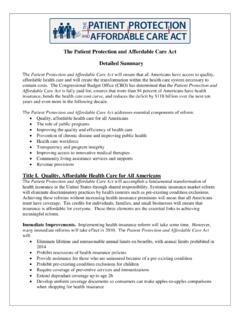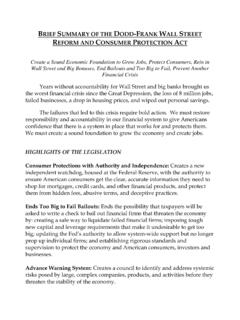Transcription of The Health Care and Education Reconciliation Act - Senate
1 The Health care and Education Reconciliation Act Together with the Patient Protection and Affordability Act, the Health care and Education Reconciliation Act will ensure that all Americans have access to quality, affordable Health insurance and put students ahead of private banks. The Congressional budget Office has determined that together, these two bills are fully paid for, will ensure more than 94 percent of Americans have access to quality, affordable Health care , will bend the Health care cost curve, and will reduce the deficit by $143 billion over the next ten years with further deficit reduction in the following decade. Historic investments in our economic future will make college more affordable and accessible through a transformation in student loan programs. TITLE I: COVERAGE, MEDICARE, MEDICAID, AND REVENUES (Finance Committee provisions) Coverage Makes plans in the Exchange more affordable by further limiting the cost of premiums and cost-sharing for individuals under 400 percent of poverty (a family of four with income less than $88,000).
2 Ensures that if costs grow faster than expected, the amount of tax credits will be reduced to more closely track the overall inflation rate. Modifies the assessment that individuals who remain uninsured pay by exempting income below the filing threshold. The individual assessment is the greater of a flat dollar payment, which has been lowered, and a percentage of income, which has been raised, as compared to the Patient Protection and Affordable care Act. Improves the employer responsibility provisions. o Large employer penalty cap raised from $750 per worker to $2,000 per worker. o Strikes the penalty for waiting periods between 60 and 90 days. o Counts full-time equivalents toward the threshold for triggering a penalty, but does NOT impose any penalties for part-time workers. o Phases in the penalties as employers become larger by discounting 30 full-time workers from the per-worker penalty, eliminating a disincentive to creating new jobs.
3 O Eliminates the special rule for construction industry employers. Medicare Provides a $250 rebate for beneficiaries who hit the coverage gap or donut hole in 2010 and fills the donut hole for brand and generic drugs by 2020. Reduces Medicare Advantage overpayments in a targeted way that reflects the different needs of urban and rural areas. Provides a more refined approach that varies rates by local fee-for-service costs on a sliding scale. Includes three to seven year phase-in and increases MA benchmarks for high-performance plans. Ensures that Medicare Advantage plans spend at least 85 percent of revenue on medical costs or activities that improve quality of care . Lowers Medicare Disproportionate Share Hospital (DSH) cuts in the Patient Protection and Affordable care Act from $ billion to $ billion and revises market basket updates to hospitals by $ billion. 2 Adjusts the utilization rate changes included in the Patient Protection and Affordable care Act to take into account the CMS imaging rule that went into effect on January 1, 2010.
4 Sets the assumed utilization rate at 75 percent for the practice expense portion of advanced diagnostic imaging services. Medicaid Equalizes and increases funding for the Medicaid expansion by providing 100 percent federal match in 2014, 2015, and 2016; 95 percent match in 2017; 94 percent match in 2018 ; 93 percent match in 2019; and 90 percent thereafter. For early expansion states, provides additional federal funding to reduce the cost of covering non-pregnant childless adults beginning in 2014. In 2019 and thereafter, all states will bear the same costs for covering non-pregnant childless adults. Increases payments for Medicaid primary care to Medicare rates in 2013 and 2014 and provides full federal support to do so. Lowers the reduction in federal Medicaid DSH payments in the Patient Protection and Affordable care Act from $ billion to $ billion over ten years. Increases funding for the territories by $2 billion, and provides territories the option to establish an Exchange.
5 Delays Community First Choice Option for one year. Narrows the definition of new drug formulations for purposes of applying the Medicaid drug rebate. Fraud, Waste, and Abuse Establishes new requirements for community mental Health centers to prevent fraud and abuse. Modifies Medicare prepayment medical review limitations. Increases funding to fight fraud, waste, and abuse by $250 million. Requires a 90-day period of oversight for initial claims of DME suppliers. Revenue Delays implementation of the excise tax on high cost Health plans until 2018 ; increases the thresholds for imposing the tax to $10,200 for self-only plans and $27,500 for family coverage. Adds adjustments for age and gender of enrollees. Delays the establishment of a $2,500 cap on FSA contributions until 2013. For individuals with Adjusted Gross Income above $200,000 for a single taxpayer and $250,000 for a married couple, equalizes the Medicare contribution treatment for earned and unearned income.
6 Closes the black liquor loophole that allows certain taxpayers to get an unintended tax credit for cellulosic biofuels. Establishes, in statute, the economic substance doctrine to prevent the use of transactions that generate tax benefits but which otherwise have no business purpose. Higher Education Provisions Under the Finance Title Provides $2 billion for community colleges to develop and improve educational or career training programs. 3 TITLE II: Education AND Health (HELP Committee provisions) Higher Education Provisions Beginning July 1, 2010, all new federal student loans will originate through the Direct Loan program, instead of through the federally-guaranteed student loan program. Includes $36 billion over ten years to increase the maximum Pell Grant to $5,550 in 2010 and to $5,975 by 2017. Indexes the Pell Grant to the Consumer Price Index starting in 2013, to match the rising costs of college.
7 Addresses the FY 2011 shortfall in the Pell Grant program. Expands the Income-Based Repayment program. Starting in 2014, the bill will cap new borrower s loan payment at 10 percent of their net income, after adjustments for basic living costs, and would forgive any remaining debt after 20 years. Invests $ billion in Historically Black Colleges and Universities and Minority-Serving Institutions. Includes $750 million for college access and completion support programs for students, including increased funding for the College Access Challenge Grant program, which funds programs at states and institutions aimed at increasing financial literacy and student retention. Ensures that the Reconciliation instructions for the HELP Committee are met by reducing the deficit by at more than $10 billion over ten years. Health Provisions Extends important insurance reforms to existing plans, including bans on lifetime and annual limits, coverage of pre-existing conditions, a ban on rescissions, limits on waiting periods, and expanded coverage for young adults.
8 Eliminates 340B inclusion of inpatient drugs; no exceptions to group purchasing exclusion. Increases the substantial investment in Community Health Centers to expand access to Health care in communities where it is needed most.



